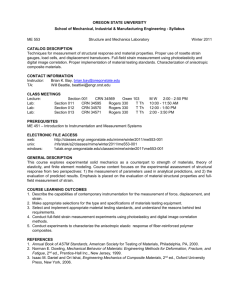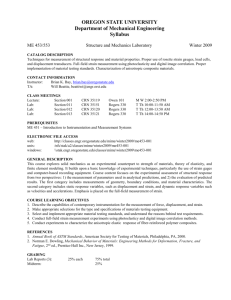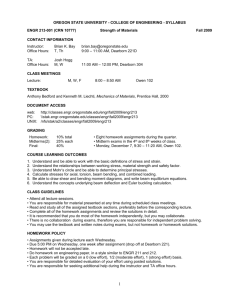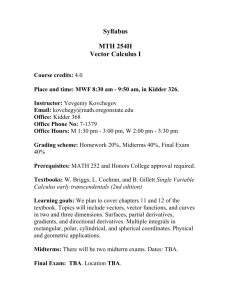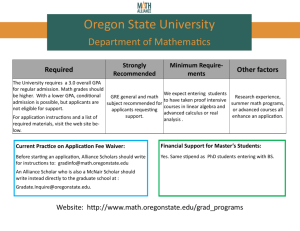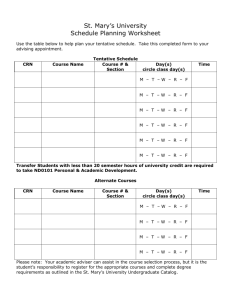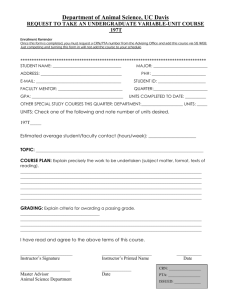ME453_W12_syllabus - Classes
advertisement
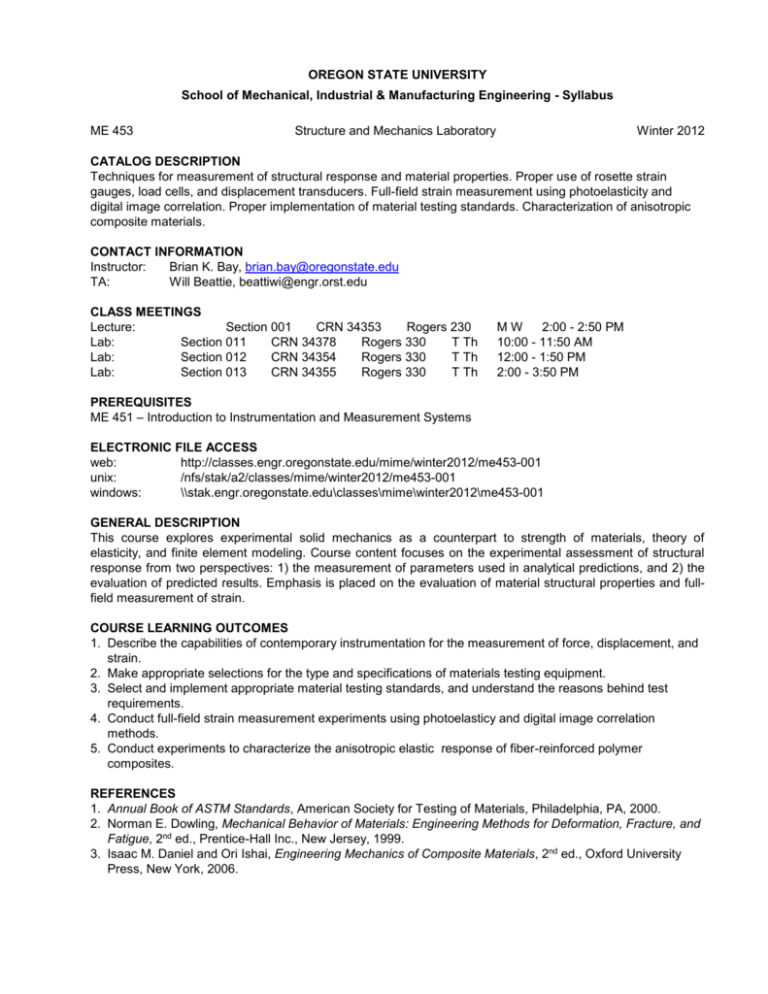
OREGON STATE UNIVERSITY School of Mechanical, Industrial & Manufacturing Engineering - Syllabus ME 453 Structure and Mechanics Laboratory Winter 2012 CATALOG DESCRIPTION Techniques for measurement of structural response and material properties. Proper use of rosette strain gauges, load cells, and displacement transducers. Full-field strain measurement using photoelasticity and digital image correlation. Proper implementation of material testing standards. Characterization of anisotropic composite materials. CONTACT INFORMATION Instructor: Brian K. Bay, brian.bay@oregonstate.edu TA: Will Beattie, beattiwi@engr.orst.edu CLASS MEETINGS Lecture: Section 001 CRN 34353 Rogers 230 Lab: Section 011 CRN 34378 Rogers 330 T Th Lab: Section 012 CRN 34354 Rogers 330 T Th Lab: Section 013 CRN 34355 Rogers 330 T Th MW 2:00 - 2:50 PM 10:00 - 11:50 AM 12:00 - 1:50 PM 2:00 - 3:50 PM PREREQUISITES ME 451 – Introduction to Instrumentation and Measurement Systems ELECTRONIC FILE ACCESS web: http://classes.engr.oregonstate.edu/mime/winter2012/me453-001 unix: /nfs/stak/a2/classes/mime/winter2012/me453-001 windows: \\stak.engr.oregonstate.edu\classes\mime\winter2012\me453-001 GENERAL DESCRIPTION This course explores experimental solid mechanics as a counterpart to strength of materials, theory of elasticity, and finite element modeling. Course content focuses on the experimental assessment of structural response from two perspectives: 1) the measurement of parameters used in analytical predictions, and 2) the evaluation of predicted results. Emphasis is placed on the evaluation of material structural properties and fullfield measurement of strain. COURSE LEARNING OUTCOMES 1. Describe the capabilities of contemporary instrumentation for the measurement of force, displacement, and strain. 2. Make appropriate selections for the type and specifications of materials testing equipment. 3. Select and implement appropriate material testing standards, and understand the reasons behind test requirements. 4. Conduct full-field strain measurement experiments using photoelasticy and digital image correlation methods. 5. Conduct experiments to characterize the anisotropic elastic response of fiber-reinforced polymer composites. REFERENCES 1. Annual Book of ASTM Standards, American Society for Testing of Materials, Philadelphia, PA, 2000. 2. Norman E. Dowling, Mechanical Behavior of Materials: Engineering Methods for Deformation, Fracture, and Fatigue, 2nd ed., Prentice-Hall Inc., New Jersey, 1999. 3. Isaac M. Daniel and Ori Ishai, Engineering Mechanics of Composite Materials, 2nd ed., Oxford University Press, New York, 2006. GRADING Course grades are derived from performance on three pre-defined laboratory tasks, an examination of conceptual/analytical understanding, and a term project. Credit is assigned as follows: Lab Tasks (3): 15% each Examination: Term Project: 45% total 20% 35% Lab Tasks: In these exercises an objective is defined and equipment is provided to investigate solid mechanics phenomena and develop skills necessary for more complex experiments. A combination of computer programming, data collection and analysis, and system modeling is required. Students work in groups, but evaluation of performance is individual. After a specified completion date at the end of a Tuesday laboratory section, students receive a set of questions to answer individually and submit responses at the beginning of the following Thursday laboratory section. In addition to other materials, questions require access to data collected during the preceding laboratory sections, as described in course handouts. Each student is responsible for access to the required data at the time the questions are assigned. Examination: This takes the form of a traditional midterm that evaluates understanding of analytical and computational material presented during the class. Term Project: Similar to the pre-defined laboratory tasks, but students will design and conduct their own experiments. STATEMENT REGARDING STUDENTS WITH DISABILITIES Accommodations are collaborative efforts between students, faculty and Services for Students with Disabilities (SSD). Students with accommodations approved through SSD are responsible for contacting the faculty member in charge of the course prior to or during the first week of the term to discuss accommodations. Students who believe they are eligible for accommodations but who have not yet obtained approval through SSD should contact SSD immediately at 737-4098. LINK TO STATEMENT OF EXPECTATIONS FOR STUDENT CONDUCT http://oregonstate.edu/admin/stucon/achon.htm
